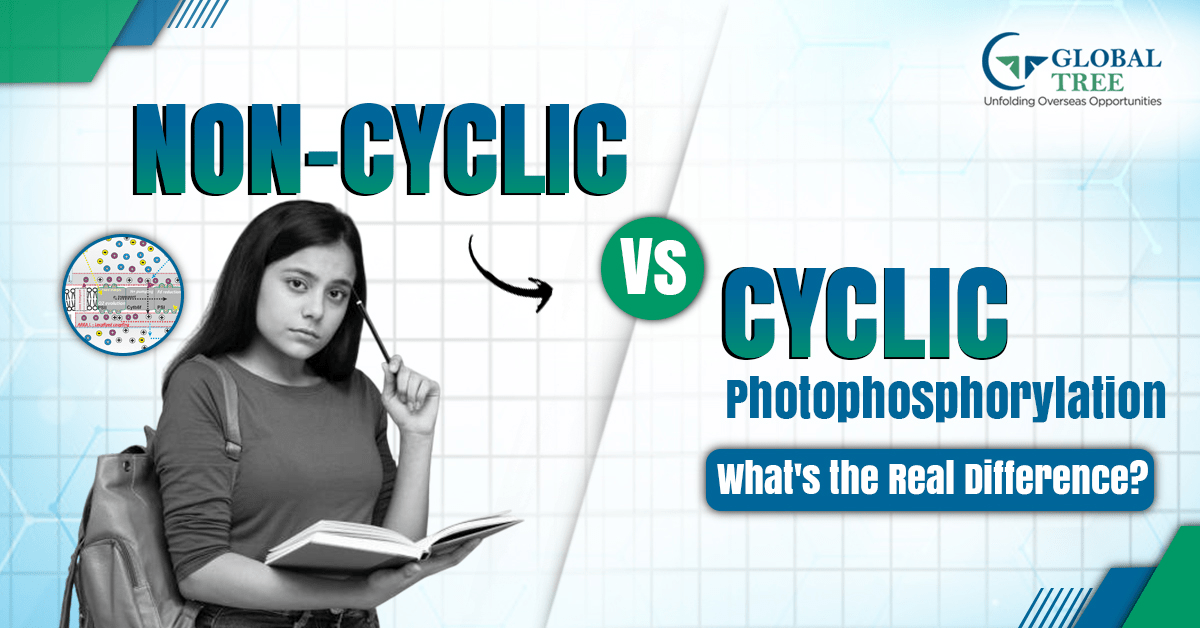Photosynthesis Explained: Cyclic vs Noncyclic Photophosphorylation

Understanding the Differences Between Cyclic and Non-Cyclic Photophosphorylation
Photophosphorylation is how plants transform sunlight energy into chemical energy in photosynthesis. Does it sound complicated? But don't fret; let's dissect it! There are two main types of photophosphorylation: cyclic and non-cyclic. Both are found within the chloroplasts in plant cells and have important functions in energy production; however, they operate differently.
(Check out: Are you confused about the 10th class science project? Here are the top ideas!)
In cyclic photophosphorylation, the electrons released from chlorophyll return to the same molecule after going through a series of carriers. The process only generates ATP but doesn't release oxygen. Consider it an endless loop of electrons that move through a loop, and energy is efficiently conserved, mostly in situations where the plant requires only ATP.
However, non-cyclic photophosphorylation can be described as a single-way journey.
Electrons aren't able to return to the initial chlorophyll molecules. Instead, they're transformed into NADP+, then into NADPH. At the same time, water separates in this process and releases oxygen as a byproduct—the pathway results in both ATP and NADPH, vital for the following phases of photosynthesis.
Understanding these two processes can help us understand how intelligent and efficient facilities are. They alter their systems based on their requirements, ensuring no wasted energy. It's pretty cool.
(Suggested Read: Why should you study Plant Sciences Course abroad?)
Cyclic vs Non-cyclic Photophosphorylation
| Feature | Cyclic Photophosphorylation | Non-Cyclic Photophosphorylation |
|---|---|---|
| Pathway of Electrons | Electrons return to the same chlorophyll | Electrons do not return; they are accepted by NADP⁺ |
| Photosystems Involved | Only Photosystem I (PSI) | Both Photosystem I (PSI) and Photosystem II (PSII) |
| ATP Production | Yes | Yes |
| NADPH Production | No | Yes |
| Oxygen Release | No | Yes (due to splitting of water) |
| Electron Source | Chlorophyll molecule itself | Water (H₂O) |
| Occurs When | ATP demand is high and NADPH is not needed | Both ATP and NADPH are needed for Calvin cycle |
| Purpose | Supplements ATP production | Provides ATP, NADPH, and releases O₂ |
| Location | Thylakoid membrane (stromal lamellae) | Thylakoid membrane (grana) |
Cyclic Photophosphorylation
It's the process of synthesizing ATP, which electron transport triggered only by PS-I accompanies. Inhibitors like CMU, DCMU, and orthophenanthroline don't inhibit this process. The process is found primarily in bacteria.
(You may also like: Horticulture and Viticulture course abroad: Know the eligibility)
Non-cyclic Photophosphorylation
This procedure involves two photosystems: PS-I and PS-II. It also generates NADPH as well as ATP. This process aids in creating organic molecules, and in the long run, it helps store energy.
Conclusion
Understanding cyclic and non-cyclic photophosphorylation is key to learning how plants make energy. These processes explain turning sunlight to ATP and NADPH, vital to photosynthesis. Knowing the distinctions and the functions of these substances, students will understand how plants live to grow, thrive, and sustain life on Earth. It's only a minor component of botany. Studying a Botany course abroad will equip you with more depth of these concepts. However, it's a significant step toward learning about the science that is the basis of all nature.
FAQ’s:
-
What is the main difference in simple terms?
-
Answer: Cyclic makes ATP only; Noncyclic makes ATP + NADPH + O₂.
-
-
Which photosystem is used in cyclic?
-
Answer: Only PS I (700nm) - PS II not involved.
-
-
Where does cyclic occur in chloroplast?
-
Answer: Stroma lamellae (non-appressed regions).
-
-
Is oxygen released in cyclic?
-
Answer: No - Water isn't split in cyclic pathway.
-
-
Which organisms use cyclic photophosphorylation?
-
Answer: Purple sulfur bacteria and cyanobacteria under stress.
-
-
Why is noncyclic more important?
-
Answer: Provides NADPH for Calvin cycle (90% of plant energy needs).
-
-
What is the electron acceptor in cyclic?
-
Answer: Ferredoxin returns electrons to cytochrome b6f complex.
-





